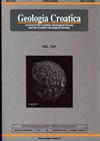The characteristics of granites in the Gaofeng and Baocheng areas, Hainan Province, China: response to subduction of the Tethyan South China Sea
IF 1.1
4区 地球科学
Q3 GEOLOGY
引用次数: 1
Abstract
During the early Mesozoic Era there was intense magmatic activity near Hainan Island, South China. As a result, the granites of Hainan Island provide information on, and are suitable material to potentially improve understanding of the Cretaceous tectonic environment of the northern margin of the South China Sea. The Gaofeng and Baocheng intrusions are composed mainly of medium- to fine-grained biotite adamellite (Baocheng) and granodiorite (Gaofeng). The two intrusions yielded U–Pb LA-ICP-MS zircon ages of 107.7 ± 6.1 Ma (Gaofeng) and 105.8 ± 2.4 Ma (Baocheng). Regarding the major elements, the Gaofeng and Baocheng intrusions had medium Si and alkali contents and high Ca, Mg, and Al contents, with an aluminum saturation index of 0.95–1.03 and 1.05–1.30. The trace element and rare earth element (REE) characteristics showed that the two intrusions have intense heavy REE/light REE (HREE/LREE) fractionation, LREE enrichment, HREE depletion, and weak negative Eu anomalies. The intrusions were enriched in high field-strength elements and depleted in large ion lithophile elements. These geochemical characteristics indicate that the Hainan Province was in a tectonic subduction environment in the late Yanshanian period. Multiple geochemical characteristics demonstrate that the granites in the Hainan Province were formed by a different mechanism and in a different setting from those in Fujian and Zhejiang. The late Mesozoic granites of Fujian and Zhejiang were formed by the Western Pacific subduction. However, Hainan Island was under an arc environment formed by the northward subduction of the Tethyan-South China Sea during the Cretaceous leading to emplacement of the Gaofeng and Baocheng intrusions.海南高峰和宝城地区花岗岩特征:对南海特提斯俯冲的响应
中生代早期,海南岛附近有强烈的岩浆活动。因此,海南岛的花岗岩提供了关于南海北缘白垩纪构造环境的信息,并且是可能提高对其认识的合适材料。高峰和宝成侵入体主要由中细粒黑云母二长岩(宝成)和花岗闪长岩(高峰)组成。这两个侵入体的U–Pb LA-ICP-MS锆石年龄分别为107.7±6.1 Ma(高峰)和105.8±2.4 Ma(宝城)。就主要元素而言,高峰和宝城侵入体的Si和碱含量中等,Ca、Mg和Al含量较高,铝饱和指数分别为0.95–1.03和1.05–1.30。微量元素和稀土元素特征表明,这两个侵入体具有强烈的重稀土/轻稀土分馏、轻稀土富集、轻稀土贫化和弱负Eu异常。侵入体富含高场强元素,贫含大离子亲石元素。这些地球化学特征表明,海南处于燕山晚期构造俯冲环境中。多种地球化学特征表明,海南花岗岩的形成机制和环境与福建、浙江花岗岩不同。闽浙晚中生代花岗岩是由西太平洋俯冲作用形成的。而海南岛则处于白垩纪特提斯-南海向北俯冲形成的弧形环境中,导致高峰和宝成侵入体侵位。
本文章由计算机程序翻译,如有差异,请以英文原文为准。
求助全文
约1分钟内获得全文
求助全文
来源期刊

Geologia Croatica
GEOSCIENCES, MULTIDISCIPLINARY-
CiteScore
2.90
自引率
23.10%
发文量
35
审稿时长
>12 weeks
期刊介绍:
Geologia Croatica welcomes original scientific papers dealing with diverse aspects of geology and geological engineering, the history of the Earth, and the physical changes that the Earth has undergone or it is undergoing. The Journal covers a wide spectrum of geology disciplines (palaeontology, stratigraphy, mineralogy, sedimentology, petrology, geochemistry, structural geology, karstology, hydrogeology and engineering geology) including pedogenesis, petroleum geology and environmental geology.
Papers especially concerning the Pannonian Basin, Dinarides, the Adriatic/Mediterranean region, as well as notes and reviews interesting to a wider audience (e.g. review papers, book reviews, and notes) are welcome.
 求助内容:
求助内容: 应助结果提醒方式:
应助结果提醒方式:


